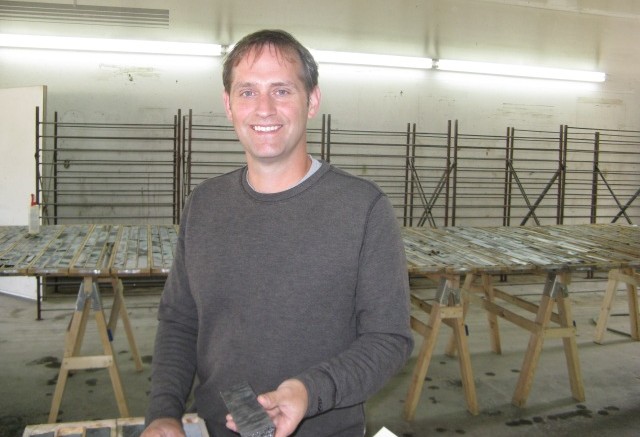When the discovery of a new gold patch rocks the mining world, it is a wondrous thing.
When the discovery is made in an underexplored area with no previously known precious metal deposits it’s even more exciting, and when the discovery stems, in part, from a simple good deed, it becomes extraordinary.
The tale of how David Palmer discovered the Borden Lake gold deposit and earned the prestigious Bill Dennis Award and title to The Northern Miner’s Mining Person of the Year for 2014 begins in 2003, about four years after he graduated from McGill University with a PhD in economic geology.
The geologist, whose PhD thesis focused on ore-forming hydrothermal fluids associated with carbonatites, was working for a junior, when a prospector he didn’t know by the name of Bob de Carle, pitched a nickel property called Sunday Lake, north of Thunder Bay.
The property didn’t fit the company’s model, so it passed.
But Palmer thought it still held promise. His view was that the material just hadn’t been presented in the right way, which masked some of what he felt were its most interesting features. So he offered to spend some personal time reworking the geological data to improve the odds that de Carle — a geophysicist by training — could find success the next time he shopped it around.
“I thought it had some really, really interesting features,” Palmer recalls in an interview at his office on Temperance Street, in Toronto’s financial district. “It was greenfield and had never been drilled.”
What Palmer thought might take him a couple of hours took an entire weekend, as he reprocessed de Carle’s data and made new tables and graphs, turning it into an eight-page document that he felt really highlighted the property’s potential.
Palmer gave it back to de Carle, wished him well and thought that was the end of the story.
It was just the beginning.
What he didn’t know was that de Carle had worked over the years with long-time industry geologist Harry Hodge, and when Hodge saw what Palmer had done with the material on the nickel property, he was impressed.
“Harry called me up and said: ‘I can’t believe what you’ve done — this is almost a 43-101 now — can you put a front and back cover on it, and turn it into a qualifying property?’”
Palmer said he would be happy to, that he wasn’t a P.Geo., but that he would get the accreditation as soon as he could.
Hodge also mentioned that he had a shell company called Probe Mines, and asked Palmer whether, when the time was right, he would be interested in taking the helm.
“It just sounded perfect,” Palmer recalls.
Hodge made good on his promise and Palmer joined Probe in November 2003. He spent most of the next six years exploring Ontario’s remote Ring of Fire region, where in 2009 he made his first discovery: the Black Creek chromite deposit. Working in such an infrastructure-challenged area, however, and having only seasonal access, convinced him that Probe should try to find a project with year-round access.
It wasn’t long after that he met two prospectors, Mike Tremblay and Jacques Robert, who told him about an outcrop they had found near Borden Lake, 12 km outside of Chapleau, in northern Ontario.
Palmer admits that his first impression of the Borden Lake property during his initial visit to the site in September 2009 was that he had “wasted his entire day.”
He says that “we knew it was a low-grade type of deposit, so when I got there, I was expecting mineralization over a much larger area … when I realized it was just a narrow ridge that the outcrops were along, I thought: ‘Oh no, it’s too thin to build tonnage.’”
During the tour, however, 40 to 50 metres off the main ridge, Palmer found a second outcrop, perpendicular to strike, that held sulphides. When he sampled it and the assays came back, the second outcrop contained the same low-grade gold found in the first outcrop on the ridge. Even then, he says, “it wasn’t so impressive that it was an obvious acquisition.”
Given the project’s location, however, just 1 km off provincial highway 101, which runs between Wawa (145 km west) and Timmins (180 km east), Palmer knew it would be relatively inexpensive to test, and that if it didn’t work out, he could walk away without having spent too much money. Probe acquired Borden in March 2010.
The funny thing, Palmer says, is that the project “didn’t really thrill me too much — even on the discovery holes.” And “it looked different from anything I had seen in gold before.”
He continues that “high-grade metamorphic rocks, no quartz veining, lots of sulphide — but the sulphide was dominantly pyrrhotite, which is not as common in gold deposits … so there was nothing about it that screamed: ‘This is a great gold deposit.’”
It took more assay results to convince him. “The first outcrop was running half a gram to a gram, but when I got further past that into the centre of the zone, we were getting 5, 10, 15 grams, so there was this higher-grade centre to the 100-metre wide gold zone,” he says. “I actually didn’t believe it. We had it re-assayed because I thought there was a problem in the lab.”
During the drill program’s second phase, Palmer and his crew drilled through the entire envelope, which turned out to be 182 metres wide, something he says was much better than the 40 metres they were expecting.
“I think that’s what investors and shareholders love about Borden,” he says. “It was a story that didn’t stop getting better, it just continued to evolve and improve.”
So far Probe has outlined a high-grade underground resource of 1.6 million indicated oz. gold from 9.3 million tonnes grading 5.93 grams gold per tonne, plus 400,000 inferred oz. from 3 million tonnes of 4.37 grams gold. A lower-grade open-pit resource adds 2.32 million indicated oz. based on 70.3 million tonnes of 1.03 grams gold and 10,000 inferred oz., based on 247,000 tonnes grading 0.8 gram.
“I think where we excelled is not taking anything for granted,” Palmer says. “We didn’t overlook things, because really, deposits are where you find them, and what we’re finding is that they’re in a lot of places that people didn’t expect.”
In late January Goldcorp tabled a friendly all-share bid to acquire Probe Mines for $526 million, in a deal expected to close in March. The major’s Porcupine gold mine in Timmins is 160 km east of Borden.
As part of the deal, Palmer will become CEO of a spinoff company called Probe Metals, in which Goldcorp will hold a 20% stake. The junior will start off with a $19-million treasury, a position from which Palmer says the team can “really hit the ground running.”
The arrangement suits Palmer, because it lets him do what he loves best: explore. “I’m really looking forward to getting out there and doing it again,” Palmer says, who is now 45. “What I love about this industry is t
he thrill of the chase. It’s going out to find it. So with Probe Metals, we get to start again and do it all over.”
Probe Metals will continue with the same management and exploration team, which works well together, is technically adept and has complementary skill sets. “I think we’ll be able to source the projects that will hopefully do the same thing as Borden, and I think we can do it faster now because we are more experienced — we’ve learned lessons on what to do and what not to do.”
Palmer says Probe Metals will use the same skills and strategies that made its precursor so successful, with a focus on neglected or overlooked precious metal projects in politically safe jurisdictions, like Canada and the U.S., where the team can add value. (Much like they did at Borden Lake, a folded belt of Timiskaming-age, 2.6-billion-year-old meta-sediments of the Kapuskasing structural zone, and a region Palmer still calls one of the most overlooked and least explored parts of Ontario.)
“You have to start thinking non-traditionally about exploration because the easy stuff is gone,” he says. “If you look at the non-traditional, there still is low-hanging fruit, because Borden was an outcrop discovery. So I think we just need a new orchard.”
Palmer calls Probe’s success and his awards this year “a little surreal,” and is quick to emphasize that it has all been a team effort. “I’m thankful for it all, but I don’t see it as me, I see it as recognition of the team of people who have done all these things. We wouldn’t have done it without the team.”
The Mining Person of the Year also pays tribute to St. Francis Xavier University in Nova Scotia, claiming he isn’t sure he would be where he is today had he not studied there. “St. FX was just the most phenomenal place to learn geology, and not just geology, but the practical, field aspects of geology. And I think that’s something that is becoming a lost art — a geologist that is able to go out in the field and map, and recognize rocks, structures and textures, and what they all mean.”
It wasn’t a large geology department — his decision to switch from biology to geology in his second year of university doubled the enrollment of the second-year geology class — but it “had some of the most brilliant minds,” he says, notably Professors Randy Cormier, Brendan Murphy and Alan Anderson.
Palmer recalls how Cormier would send him to the outskirts of Antigonish to find outcrops, while Anderson taught him how to look at different scales, from microscopic to continental, and Murphy instilled in all of his students a passion for geology that eventually led Palmer to graduate studies. (“Grad studies weren’t something I had even considered,” he says. “But after my third year of St. FX, they were something I couldn’t conceive of not doing.”)
Palmer also credits a lot of his success to three major influences: His father Bill (a geologist who spent much of his career at Inco — Palmer says he still remembers the day in the early 1980s when his dad was on the cover of The Northern Miner); Sig Weidner, who he worked for at Rio Algom during summers as an undergrad, and who taught him the skills required to be an exploration geologist; and Alex Po, a geologist who he worked with at his first junior company after graduation, called Titanium Co., who taught him the ropes about junior companies and Bay Street. (As a naive geology grad, he explains, he always thought he’d work for his entire career at a company like Noranda, Inco or Falconbridge, and retire at the age of 65. But he soon realized that “permanent” meant at most three years, and that there was a whole world of junior explorers that he didn’t even know existed, thanks to Po.)
“It is interesting when I look back at the people who mentored me early in life and in my career,” Palmer says. “My father, Sig and Alex were all successful exploration geologists with major discoveries under their belts: my father in Sudbury; Sig, also a Bill Dennis Award winner, in Chile; and Alex in Guyana. I don’t think I could have asked for better role models to learn from.
“What I have learned most is that no one person does it alone and success is the sum of a lifetime of guidance from everyone who has helped you along the way. In my case, this is a lot of people.”
In an email to The Northern Miner, Weidner (currently vice-president of exploration at Guerrero Ventures) says Palmer deserves all the accolades and recognition. “He has not let success get to his head and continues to be a modest, polite and ‘down-to-earth’ type of guy.
“David has always struck me as a hard-working, diligent, intelligent and persistent explorationist and geologist, with a positive attitude — traits he carries with him to this day,” Weidner continues. “He had, and continues to have, an ability to view things from the ‘big-picture’ point of view, at all times keeping his eyes on the prize and the ‘endgame’ in mind.”
Po contributed his reflections, too, noting that Palmer “has a keen, analytical mind and curiosity for scientific knowledge that is not restricted to his own field,” and that he “distinguished himself as a field geologist because of his inherent industry and devotion to duty.” He described Palmer as having “the natural ability and capacity to make good in any field pertaining to the mining industry — including being an entrepreneur. I told him so, and he listened!”
For his part, Palmer says the accolades are “heady stuff,” but still wonders: “Did everyone get it wrong?”
But he does admit it feels good that the Borden project is going to turn into a mine, create jobs and contribute to the economy.
“I think it’s going to be a positive thing and it’s going to change some peoples’ lives,” he says. “I know for some of our investors, it has already changed theirs. We get emails and comments in from investors saying: ‘Thanks, I was just able to pay off my mortgage,’ or ‘I was able to do all these things,’ and it is so nice to hear that you actually did something positive.’”






“The tale of how David Palmer discovered the Borden Lake gold deposit”
… wait a second, Dave Palmer never discovered this deposit, it was Mike Tremblay and Jack Robert that found this about 20 years ago and were finally able to sell the land to a mining company recently. The two of them had been working this property for their entire careers trying to prove to people that there’s gold there, and now that they finally have, they get snubbed like this? That’s pretty lame, you should probably check your facts a bit harder in the future.
And so should the PDAC board who chooses the recipients of this award, cause it should really be going to all three of these people, not just the geologist but the prospectors that made the initial discovery as well.
Lucky the people who showed Palmer the discovery outcrop got mentioned.
Quote from Dave Palmer himself
“We are honoured to receive this award from the Ontario Prospectors Association for the Borden Gold Project,” said David Palmer, President and CEO of Probe Mines. “It is a validation of the dedication and excellent work that the Probe team has done in advancing the Borden Gold Project into one of the premier new gold projects in Ontario. It took the combined vision and work of many people to advance the project to this point. From the prospectors, Jack Robert and Mike Tremblay, who made the initial outcrop discovery; to the entire Probe team, particularly our field team and geologists Craig Yuill and Breanne Beh, who all work tirelessly on the project.”
Hmmmmm!!!!! now what if Mike Tremblay and Jack Robert had decided to show the outcrop to someone other than David Palmer?
Some nerve accepting this award without insisting they be included.
Mining man of the year eh!